
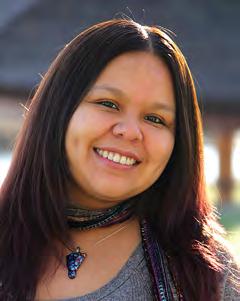



Our hands go up to the Elwha Klallam Tribe for hosting Canoe Journey this year. All the work, training, and anticipation that led up to the Paddle to Elwha rounded out into a successful journey, despite the scare of a tsunami advisory, and an inspiring protocol – a celebration of the Elwha River and its revitalization was a sight to see!
The humbling and inspirational March Against Addiction kicked off the always entertaining Swinomish Days weekend this month. Our community marched and gave voice to all who have been touched by addiction, be it personal or a loved one, reaffirming that “THIS HAS TO STOP!” is from all of us. New to the march this year was all the food and fun activities that greeted everyone at the end.
With all the action of canoe racing, sla hal stick games, and 3-on-3 basketball, Swinomish Days was well attended and continues to be one of kind. This celebration is an evolution of so many years! The Tribal Archive recognizes our ancestor’s influence on today’s event with historic photos that bring us back to the early days of Swinomish festivals.
Is anyone else feeling those end of summer blues? Get in those last days of summer family time!

Do you have a Canoe Journey story to share? Submit your stories and photographs to qyuuqs@swinomish.nsn.us
We hope you enjoy this issue of qyuuqs News!
ya lə ka but
Steve Edwards, Chairman (360) 840-5768 | sedwards@swinomish.nsn.us
ya qua l us
Brian Porter, Vice Chairman (360) 840-4186 | bporter@swinomish.nsn.us
kuts bat s t
Jeremy Wilbur, Treasurer (360) 770-7447 | jjwilbur@swinomish.nsn.us
sa-bal-sha-g d
Rodney John, Secretary (360) 708-1387 | rjohn@swinomish.nsn.us
nu-was-k -luk
Fred Cayou (360) 708-2401 | fcayou@swinomish.nsn.us
siwəlcəʔ
Alana Quintasket (360) 302-0971 | aquintasket@swinomish.nsn.us
spi sta yup tun
Greg Edwards (360) 854-8612 | gedwards@swinomish.nsn.us
kaniʔtəd
Tandy Wilbur (360) 770-3050 | tandywilbur@swinomish.nsn.us
qws stania
Aurelia Bailey (360) 853-6376 | awashington@swinomish.nsn.us
taləq talə II
Barbara James (360) 391-3958 | bjames@swinomish.nsn.us
y llakab l
Bruce James Jr. (360) 708-5779 | brucejames@swinomish.nsn.us
The mission of qyuuqs News is to provide monthly communication to Swinomish Indian Tribal Community Members near and far. We are committed to serving as an apolitical forum for the Swinomish governing officials and all Community Members. qyuuqs News is not intended to reflect the official position of the governing body at Swinomish Indian Tribal Community but rather reflects the ideas, events, and thoughts of individual Community Members and Tribal staff. As such, the Swinomish Tribe makes no claim as to the accuracy or content of any of the articles contained therein.
17337 Reservation Road, La Conner, WA 98257
Phone (360) 466.7258
*SUBMISSIONS
Send your news tips, stories, and photos to: qyuuqs@swinomish.nsn.us
Submission deadline: 10th day of the month
QYUUQS NEWS
Caroline Ammons, Editor qyuuqs@swinomish.nsn.us
SWINOMISH COMMUNICATIONS
Heather Mills, Communications Manager
Sarah Kellogg, Content Journalist
Katie Bassford, Staff Photographer
Jordan Ekdahl, Graphic Designer communications@swinomish.nsn.us
ADVISORY COMMITTEE
Tracy James, John Stephens, Kevin Paul
This issue is available online at swinomish-nsn.gov/who-we-are/page/ qyuuqs-news
Photos credits: qyuuqs News Staff or as credited. All rights reserved.
Facebook: Swinomish qyuuqs News
Linkedin: Swinomish Indian Tribal Community
*qyuuqs News is made available for viewing on the Internet
Website: swinomish-nsn.gov
@SwinomishSenate
When submitting information, stories, and/or photos, please be aware everything published in the print version of qyuuqs News is also published on the Internet and is available to the world. Please consider carefully whether your submissions contain anything you feel may not be suitable or appropriate for the Internet. By submitting your information, stories, and/or photos to qyuuqs News, you agree to publishing your submission in both the print and online versions of qyuuqs News. qyuuqs News is a publication of the Swinomish Indian Tribal Community produced by Swinomish Communications.
SWINOMISH PUBLIC HEALTH
Where is the summer going? Hopefully all of you are getting plenty of quality time outdoors and with family and friends – because it’s that time of year again to think about getting your youth back to school and keeping them healthy during the year.
One of the most important health steps is staying up to date on vaccinations. In the state of Washington, vaccines are free for all kids under age 19 through the Washington State Childhood Vaccine Program, regardless of insurance status, and certain vaccinations are required for school attendance.
If you have questions about vaccines, or if you’re not sure when you or anyone in your family is due for one, talk to your healthcare provider or give the Medical Clinic a call at (360) 466-3167.
It’s not too late to get caught up on vaccinations to ensure a healthy start to school!

Pursuant to Swinomish Tribal Code Title 2 – Tribal Government, Chapter 1 – Elections, Section .120(A) (4), the Swinomish Election Board announces the availability of Petitions for Nomination.
Petitions will be available from the Swinomish Election Officer beginning Monday, October 20, 2025.
Terms expiring:
Senate Seat 3 – Brian Porter, Incumbent
Senate Seat 4 – Greg Edwards, Incumbent
Senate Seat 5 – Tandy Wilbur, Incumbent
In order to obtain a Petition for Nomination, pursuant to STC 2-01.120(D), a Potential Candidate “shall submit a $300 non-refundable candidate fee.” This fee shall be paid to the Tribal Accounting Department and a copy of the receipt submitted to the Election Officer at the time the Petition for Nomination is obtained.
The closing date for petitions is November 19, 2025.
Please contact Swinomish Election Officer Wendy Otto with questions about this process. Phone: (360) 466-1134 Email: wotto@swinomish.nsn.us.
At the August Senate meeting the Senate approved a resolution changing the Tallawhalt Steering Committee name to Swinomish Housing Development.
8 A.M.-4 P.M.
MONDAY-FRIDAY
In today’s healthcare environment, efficiency, patient satisfaction, and staff wellbeing are more important than ever. As part of their ongoing commitment to providing high-quality, sustainable care, Swinomish Wellness operating hours have been adjusted to 8 a.m.-4 p.m. (still Monday-Friday).
Enhanced Efficiency: A 4 p.m. closing better reflects actual patient traffic, helps avoid late-day scheduling gaps, and creates a more structured and productive workday.
Improved Staff Morale and Retention: Earlier end times allow staff more time for personal needs, reducing burnout and supporting long-term retention. A wellrested team means better care for patients.
Better Access to After-Hours Services: Ending the work day earlier allows staff to provide timely referrals to after-hours care without prolonging their day – keeping continuity of care intact.
Improved Internal Operations: The new schedule provides time for team meetings, staff trainings, and improved communication – strengthening care delivery and team cohesion.
Additional Support
Clients can still complete treatment services such as groups, assessments, and UA testing at any of the didgʷálic Wellness Center locations. To see a doctor or schedule an appointment, please call (360) 466-1024.
SWINOMISH ANNUAL FRYBREAD COMPETITION
FRIDAY, AUGUST 29
2 p.m., SENIOR CENTER
Reach out to Mandy to sign up. We also need judges.
Winner gets their name on the trophy and a trophy to take home.
Plus a Frybread Champion Hoodie!

From registration and materials to study skills and coaching, Swinomish HS+/GED program staff will support your journey 100%!
Contact Sally Schroeder (360) 630-3723 sschroeder@swinomish.nsn.us
AUGUST 26
Tasting Table with Michelle, 12-1 p.m. Fitness Center Kitchen
AUGUST 28
Annual Swinomish Clambake, 12 p.m. swədəbš Park
SEPTEMBER 1
Labor Day, Offices closed
SEPTEMBER 2
Senate Meeting, 9 a.m. Senate Chamber or Zoom
SEPTEMBER 3 + 10
Build a Better Relationshiop With Your Finances, 6-7 p.m. Social Services
SEPTEMBER 6
Swinomish Mentorship Golf Outing, 11 a.m.-1 p.m. Swinomish Golf Links
SEPTEMBER 10
SSA Futures: Community, Culture, and Code, 11 a.m.-2 p.m. Wa Walton Event Center
SEPTEMBER 13
Small Business Workshop, 9 a.m.-4 p.m. Social Services
SEPTEMBER 17
Community Update Meeting: Enterprises: Casino, Gas Stations + Cannabis, 6-7 p.m. Senate Chamber or Zoom
SEPTEMBER 25
Women’s Health Day, 8 a.m.-4 p.m. Swinomish Fitness
OCTOBER 7
Senate Meeting, 9 a.m. Senate Chamber or Zoom
OCTOBER 13
Indigenous Peoples Day, Offices closed
OCTOBER 22
Community Update Meeting: Fisheries + Hunting, 6-7 p.m. Senate Chamber or Zoom
AUGUST 7-10
3-on-3 Basketball Tournament

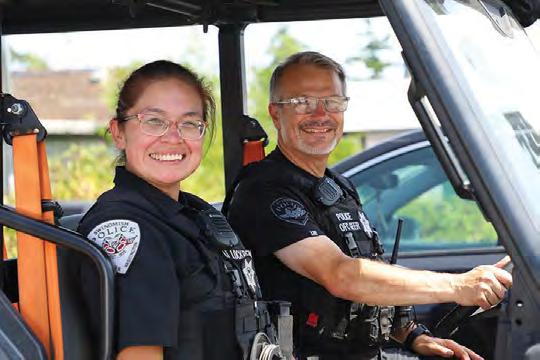



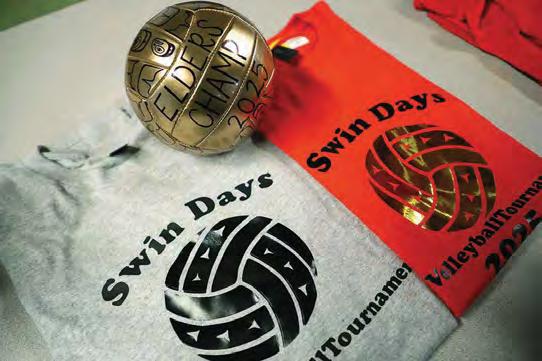


With another Swinomish Days in the books – this year marking the 12th annual – the Tribal Archive is recognizing the cherished celebrations of our ancestors with this special photo tribute.
These festivities not only tell the story of our past but also highlight how we continually uphold these important traditions today, ensuring our cultural legacy lives on.






From the Tribal Archive: Connecting Our Past Celebrations To Our Present Canoe race in the Swinomish Channel during the Puget Sound Indian Fair – c. 1930, Ferd Brady Collection Courtesy of Center for Pacific Northwest Studies

L-R:
SARAH KELLOGG, SWINOMISH COMMUNICATIONS
Six students spent four weeks at a boot camp this summer with instructors from the Machinists Institute, a non-profit educational institution that serves the aerospace, manufacturing, and machinists industries. Established by the International Association of Machinists District 751, the institute offers a variety of educational options and training paths. The training provided here at Swinomish was conducted in their mobile training trailer.
The boot camp students were exposed to several vocational trades that included welding, commercial painting, 3D printing, machining, and hydraulics. They also had the opportunity to take tours at HF Sinclair and Janicki Industries.
Workforce Development Manager Christina Adams reports the students made such a positive impression that the Machinists Institute is looking for further educational opportunities to partner with Swinomish.





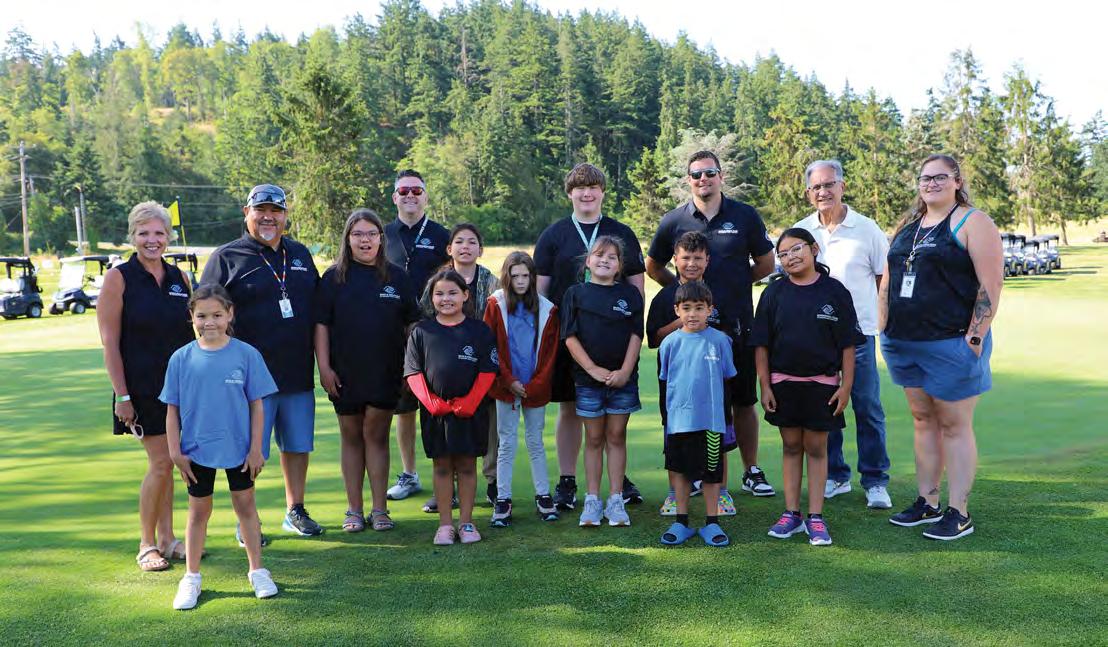


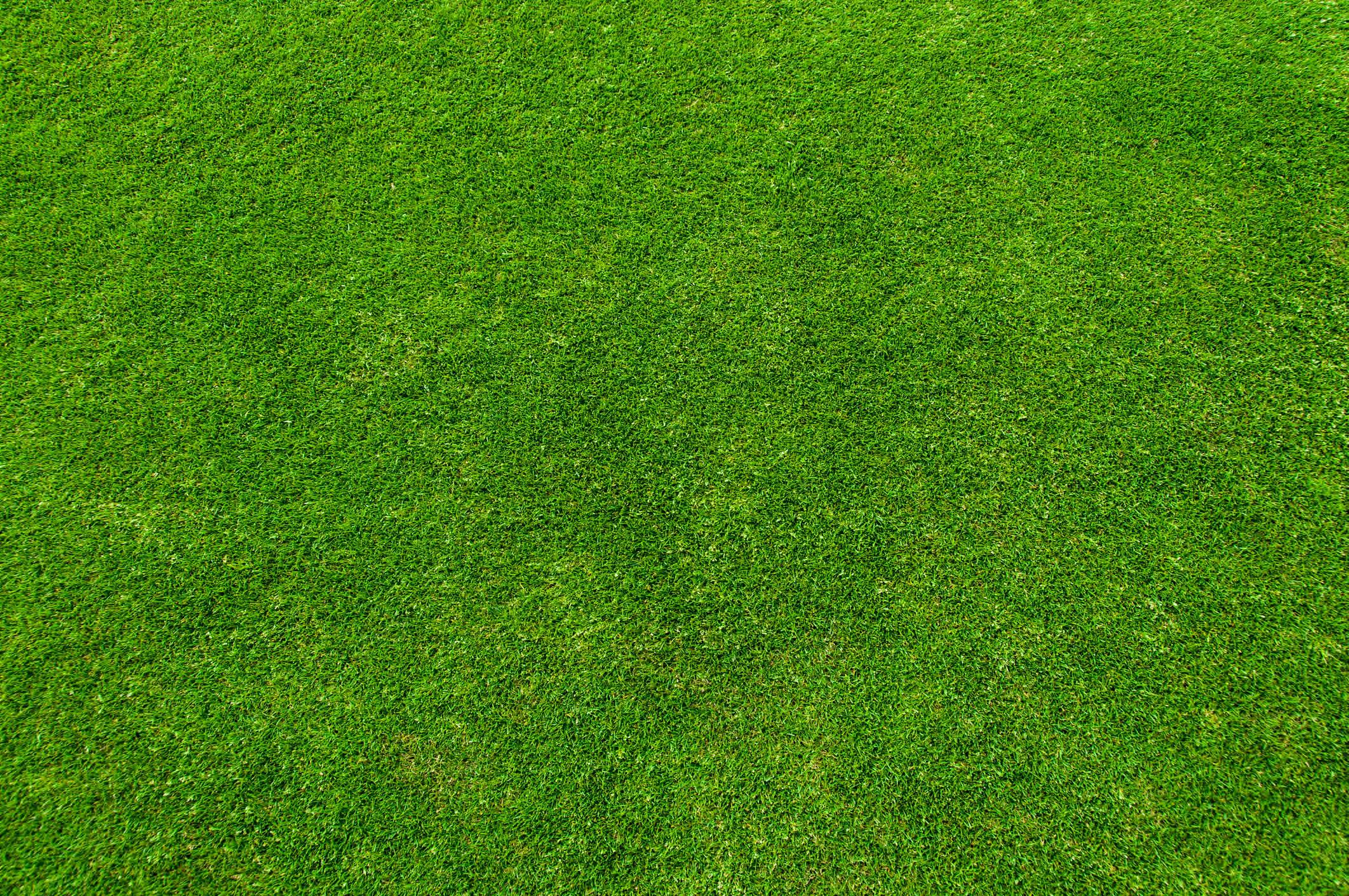

Swinomish tribal members and SITC Fisheries Department employees gathered with First Nations and Indigenous Guardians at Quadra Island, BC, to visit clam gardens on June 26
MONDAY, JULY 21, 2025

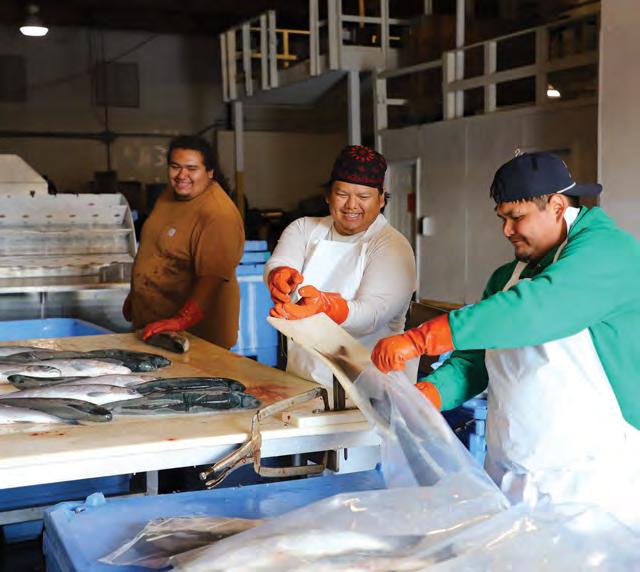

OF ENVIRONMENTAL PROTECTION & PUBLIC HEALTH
With an active start across Canada and an “above normal” fire potential rating here in the Pacific Northwest through September, it is time to prepare for wildfire smoke.
Wildfire smoke contains fine particulate matter (PM2.5) and chemicals released from the materials burned. These can pose health risks, especially for individuals with respiratory and heart conditions. Symptoms from wildfire smoke exposure include coughing, respiratory irritation, shortness of breath, headaches, chest pain, and watering eyes. Even brief exposures can lead to symptoms.
People in “sensitive groups” are at a higher risk of health effects due to wildfire smoke. This group includes:
‣ People with asthma or chronic bronchitis; chronic obstructive pulmonary disease (COPD); and/or cardiovascular disease
‣ Young children and infants
‣ Those who are pregnant
‣ Older adults and elders
‣ Outdoor workers
Being prepared and knowing when wildfire smoke is impacting our region can help you minimize exposure and keep you and your family safe.
The Department of Environmental Protection monitors real-time air quality, wildfires, and smoke forecasts. The department issues notifications to keep the community informed when wildfire smoke is expected to impact our region. Additionally, you can check the real-time air quality data by visiting AirNow.gov, which is also available as a mobile phone app. The Washington Smoke Blog located online at wasmoke.blogspot.com also provides information about wildfires and expected impacts in our region.
Have a plan in place to limit your exposure to wildfire smoke – and be ready to implement it if smoke blows

in! This means preparing to stay indoors and having a store of food, water, and medications ready. Don’t forget pet supplies, too! Now is also a good time to replace the filters on any air purifiers or filtration systems you have.
Smoke can get in from open doors, windows, and gaps around the frames or seals. During wildfire smoke events, keep doors and windows closed, and block cracks with towels or a door draft stopper. Both air purifiers and boxfan filters are efficient at removing smoke particles in an appropriately sized room. For a box-fan filter (vimeo. com/858511322?), use a MERV13 or higher filter, which are recommend for use in smaller rooms, like a bedroom. If you have a commercial air purifier, check the room size that the filter is rated for.
Not all purifiers (box fans or otherwise) will remove harmful gases. The best practice is to have an air purifier that is CARB certified and includes activated charcoal. Filtering is also important. For example, it is better to have one room with clean air than a whole house with only slightly improved air. Choose a room you and your family can be in for a while – like a bedroom. Make sure to check and replace filters when they become dirty, which can happen frequently during smoke events.
It is also recommended that you avoid other sources of indoor air pollution during wildfire smoke events. This includes vacuuming, frying foods, and lighting candles. Regular dusting can help clean up any smoke particles that have settled in your home. Use microfiber or a similar material that traps particles because moving them around or disturbing them will just add to the indoor smoke.
If you must go outside, have easy access to any necessary medications, and wear appropriate protective equipment like an N95 mask. When driving to or from work, make sure to keep your car on recirculate. There are filters made for cars as well. Stay informed and prepared this wildfire smoke season!
ATTENTION:
AFTER-HOURS
HOUSING & UTILITY
EMERGENCIES



SARAH KELLOGG, SWINOMISH COMMUNICATIONS
Dams Removed. A River Reborn. Spirits Restored. The theme for this year’s Canoe Journey is a celebration of the Elwha River and its revitalization. The removal of two dams from the river in 2014 was the largest dam removal project in the United States until the 2024 removal of the Klamath River dam.
In a National Park Service publication, former Lower Elwha Klallam Tribe council member Carla Elofson called the Elwha River the cultural “core of our people,” and added that “there is a lot of serenity being on the river. It’s very spiritual. Our traditional stories, our birthing stories come from the river.”
The Elwha Dam, built from 1910-1912 and the Glines Canyon Dam, 1927, were built to generate electricity for industries in the Port Angeles area including lumber and paper mills. Neither dam was built with the required fish ladders, causing great harm to the once extensive salmon runs. The reduction in sediment load also caused the delta at the mouth of the Elwha River to erode, affecting clams and other animals dependent on the habitat.
The Lower Elwha Klallam Tribe advocated for the removal of the dams for many years, and the Elwha River Ecosystem and Fisheries Restoration Act was passed in 1992. Controversial and unpopular at the time, the federal government was finally able to purchase the dams in 2000 and began removal in fall of 2011.
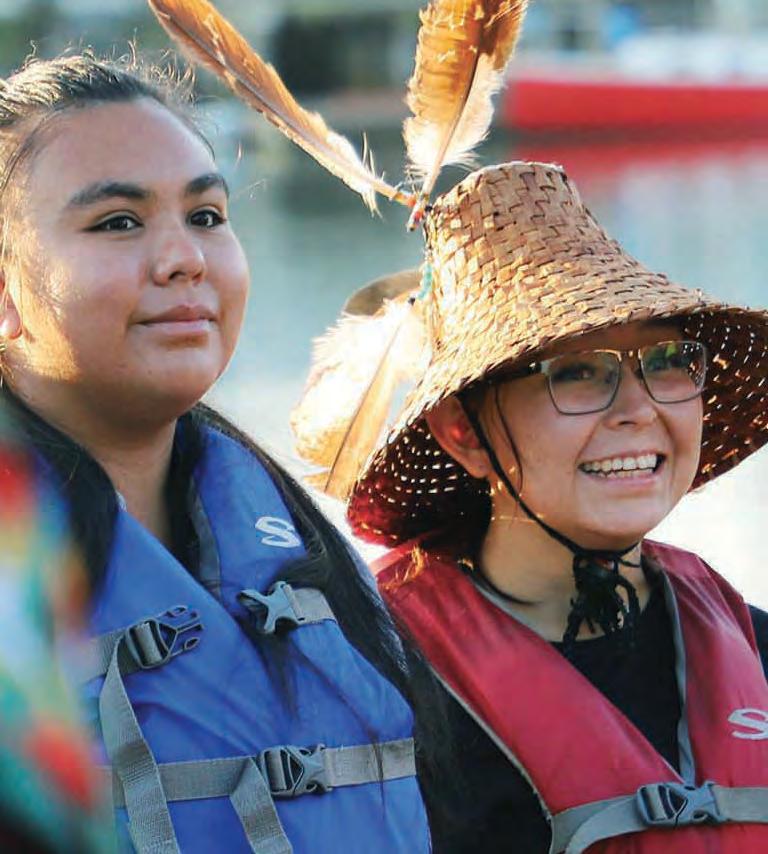
Since the removal of the dams, extensive restoration has taken place. One of the largest ecological restoration projects in the country, it will be an ongoing project for many years. Change is happening, though. Seeds and sediment are moving downstream, mammals are returning, and American dippers – birds that feed on insects and fish eggs – are showing traces of marine nutrients that salmon carry upstream.
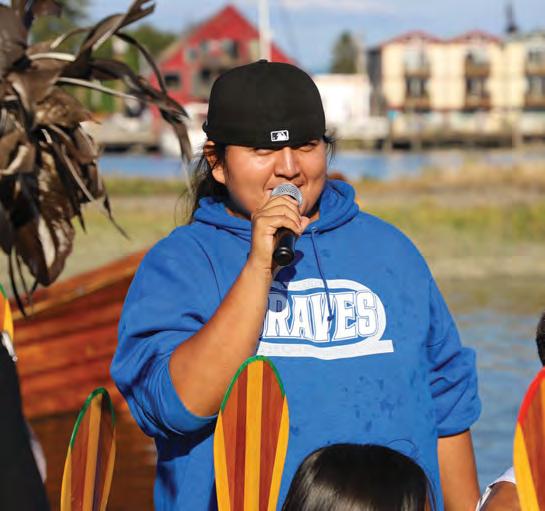
As canoe families neared the end of their journey this year, their travels were interrupted when a tsunami advisory was put into effect for coastal regions in the state. The cause was an 8.8 earthquake near the Kamchatka Peninsula, Russia, on July 29. The earthquake generated tsunami waves that prompted warnings and advisories across the Pacific, including Hawai’i and the U.S. West Coast.
While predictions were for a foot or less along the outer coast of Washington, the potential danger from the waves and strong currents were cause for concern for Canoe Journey participants. Emergency Management personnel and tribes stayed in contact with canoe families to ensure the safety of all involved. Although the advisory was canceled late Wednesday morning, the continued currents and bad weather impacted canoe families leaving from Neah Bay.
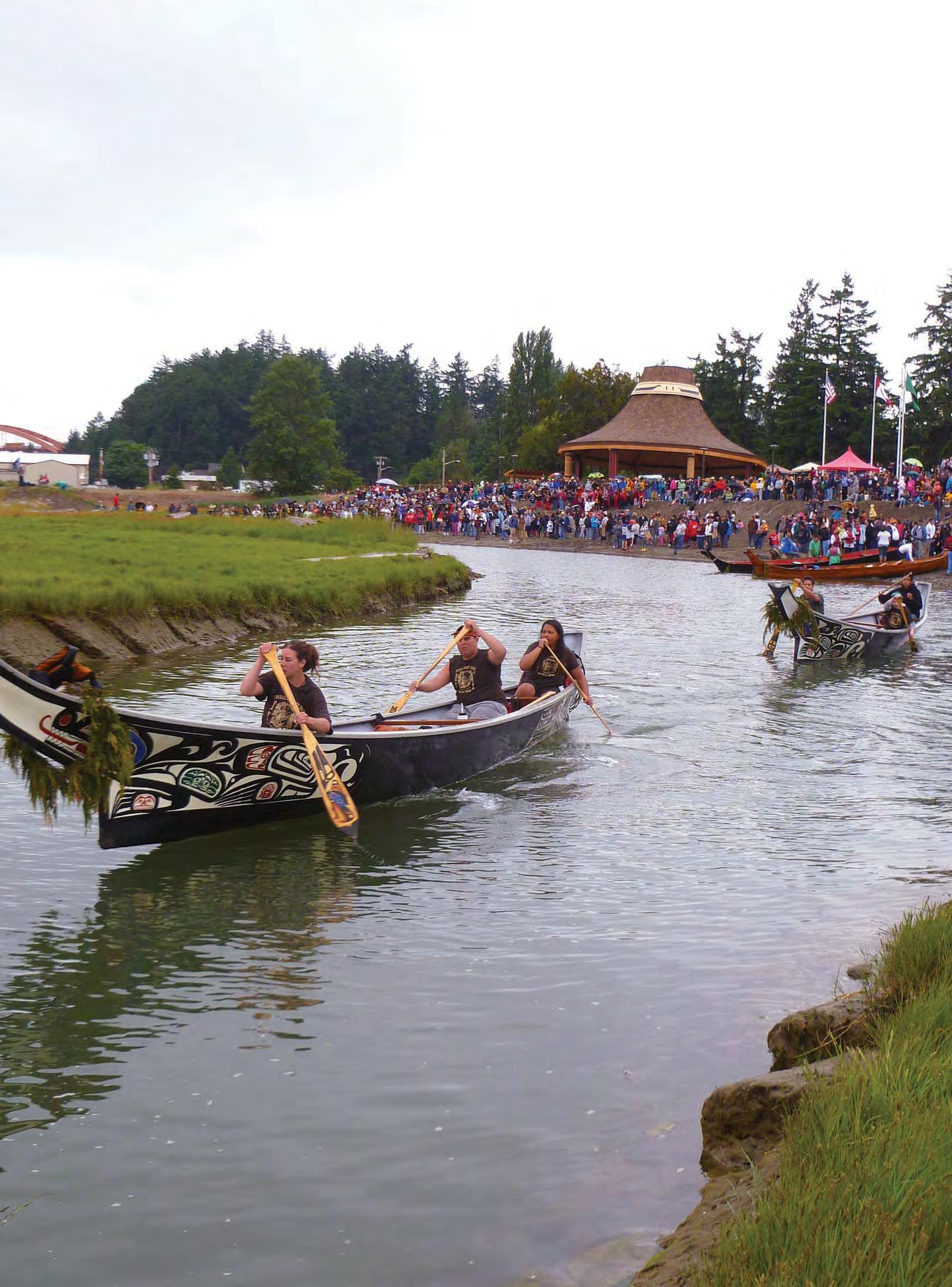
Elwha Klallam Tribe
Signatories of the Treaty of Point No Point, 1855, land was not initially set aside for the Lower Elwha Klallam Tribe. Their current land base was acquired by the United States in trust for the tribe in 1935-1936, and proclaimed as the Lower Elwha Reservation in 1968. Historically, the Klallam people lived throughout the northern Olympic Peninsula with over 33 village sites from the Hoko River to the Puget Sound. What is now Port Angeles was a Klallam village called č ixʷícən (Tse-whit-zen).
Klallam language is closely related to the Northern Straits dialects: Saanich, Lummi, Samish, Songish, and Sooke. Within the language there are several dialects, so there is some variation between villages.
The Lower Elwha Klallam Tribe previously hosted Canoe Journey in 2005.
The Native Canoe Project was proposed by Quinault elder Emmett Oliver to ensure the representation of Native culture in the 1989 Washington Centennial celebrations. He said that the project was “a vehicle for preserving Indian culture and tradition for future generations and a way to help build understanding and bridge the gap between the dominant culture and the Native culture.”

Channel Town Press News article
July 26, 1989
From the Swinomish Tribal Archive Collection
Funds were set aside, and cedar logs were felled under the 1978 Religious Freedom Act. Swinomish received logs from Baker Lake, which were then carved by Roy Edwards from Chemainus Bay on Vancouver Island.
On July 21, 1989, canoes from 17 tribes, including Swinomish, converged on Golden Gardens Park. The Seattle Times reported, “A roar of encouragement arose from the beach in a great surge of pride for the carvers, the canoes, and the paddlers who performed as though they had manned those canoes lifelong.” An audience of 5,000 met them there, and festivities continued with a parade, canoe races, the Northwest Indian art show, and activities hosted by the Daybreak Star Indian Cultural Center.
Carver David Forlines (Quileute) told a Seattle Times reporter that organizers wanted to “counter the problems of alcohol and drugs that we have on the reservation. The answer is ‘culture.’ If you get people involved in re-discovering their culture, in really caring about it, they are so busy they don’t have time for the other stuff.”
It was at Paddle to Seattle that Frank Brown (Heiltsuk) invited participants to travel north to his homelands at Bella Bella, British Columbia, in 1993, and the annual Canoe Journey was born.
Canoe Journey has grown immensely to more than 100 canoes each year, with participants from across the globe. Participants travel ancestral waterways and reclaim culture, language, and songs and experience healing.
Excerpt from “Canoe Journey’s sphere of influence growing.” Indian Country Today, August 12, 2009:
“It’s beautiful and that was the whole purpose of it in the first place,” said Swinomish cultural educator Linda Day who worked on the first Canoe Journey 20 years ago.
“The paddle brings back everything in our culture. It brings back the carving of the canoes from the cedar trees, the carving of the paddles. … It brings back (knowledge) of navigation, the tides, the winds, learning everything about the water, learning to respect it again, learning where all of the spiritual sites are along the way as they travel.”
She remembered the first time the Canoe Journey stopped at Swinomish’s shores. “Our culture, we had lost it for so many years. … When we brought (canoe travel) back, the elders had tears in their eyes. They didn’t think that they would ever see this again before they died.”
Canoe Culture Beyond the Salish Sea
Greenlandic Inuit, Māori from Aotearoa New Zealand, Ainu from Japan, and Tao from Taiwan have all participated in Canoe Journey throughout the years, connecting Indigenous people beyond the Salish Sea through shared canoe culture. In a 2023 article for the Taipei Times, Si Mateneng of the Tao community shared of his Canoe Journey experience, “I felt that I was a nobody at first,” he says. “But after paddling, they started introducing my name, where I was from and that I also came from a [boat] culture. Only then could I share my traditions with them.”
1) Every stroke we take is one less we have to make. Keep going!
2) There is to be no abuse of self or others. Respect and trust cannot exist in anger. It has to be thrown overboard, so the sea can cleanse it.
3) Be flexible. The adaptable animal survives.
4) The gift of each enriches us all. Every story is important. The bow, the stern, the skipper, the power puller in the middle — everyone is part of the movement.
5) We all pull and support each other. Nothing occurs in isolation.
6) A hungry person has no charity. Always nourish yourself. The bitter person, thinking that sacrifice
The Longest Journey is Yet to Come
With a distance of more than 500 miles for the farthest tribes, the longest Canoe Journey distance has been to Bella Bella, British Columbia. A 1993 Seattle Times article shared that the Quileute Tribe would be leaving from La Push into the Strait of Juan de Fuca to Victoria, then head up north through the Inside Passage in late May of that year with celebrations beginning June 27. That distance will increase in 2027, when Canoe Journey is slated to head to Ketchikan, Alaska!
means self-destruction, shares mostly anger.
7) E xperiences are not enhanced through criticism. Who we are, how we are, what we do, why we continue flourish with tolerance.
8) The journey is what we enjoy. Being part of the journey requires great preparation; being done with a journey requires great awareness; being on the journey, we are much more than ourselves.
9) A good teacher allows the students to learn. We can berate each other, try to force each other to understand, or we can allow each paddler to gain awareness through the ongoing journey.
10) When given any choice at all, be a worker bee — make honey!

2008
From 2008-2011 canoe families from a handful of tribes, including Swinomish, participated in the Tribal Journey Water Quality project. A collaboration with the United States Geological Survey (USGS), the project fitted canoes with special probes to measure water temperature, turbidity, oxygen, acidity levels, and salinity. In one news article at the time, Eric Day shared about the project, “We want to educate people about the reality the Puget Sound isn’t as healthy as they think it is.”
Eric Grossman, a USGS geologist and advisor for the project said, “I don’t think there’s any group that spends so much time on the coastal waters. Who else to ask about the health of our coastal environment?”
A technical report for the project was published in 2009, and can be found on the Swinomish website at swinomish-nsn.gov/media/401.




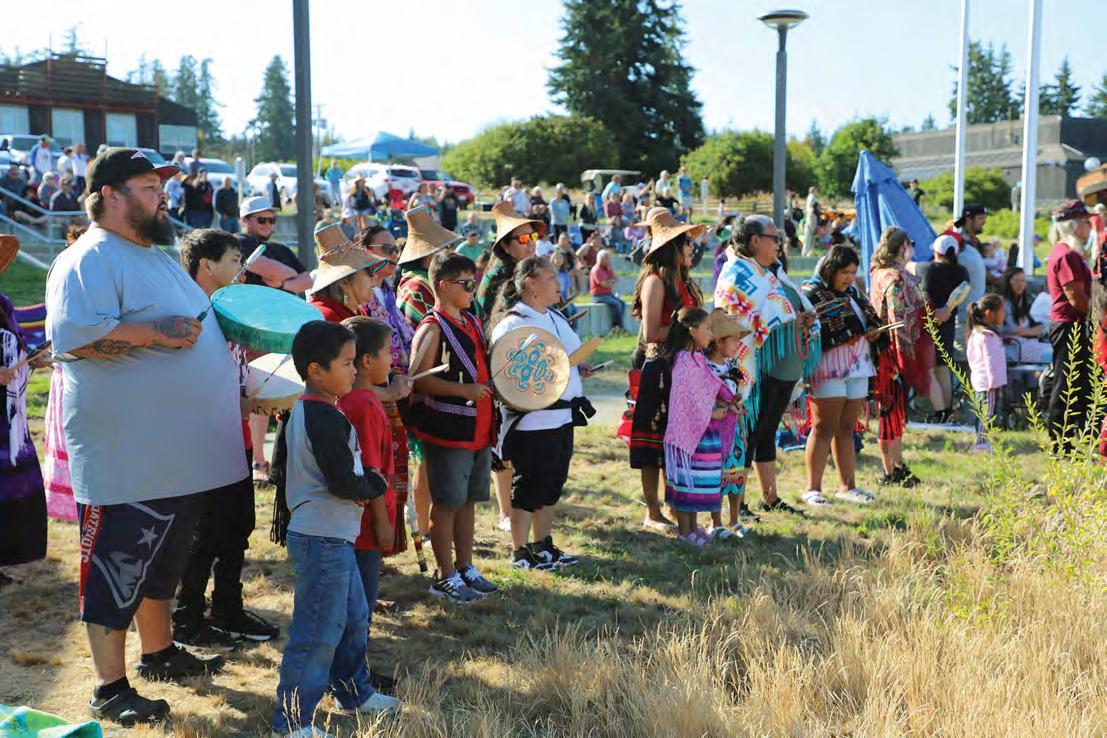
The Edwards Family sings their family song as the canoes are welcomed ashore

Bat tested positive for rabies in Skagit County: A bat found in Skagit County (not on the Swinomish Reservation) tested positive for rabies the week of August 11. The family is working with Skagit County Public Health for post exposure prophylaxis. This is a good reminder that bats can carry rabies and to avoid touching them, especially if they look sick. If you suspect that you have come in contact with a bat, or find a bat in your house, please reach out to your healthcare provider and Swinomish Public Health.
Increase in COVID-19: The number of people who report being infected with COVID is increasing statewide, including an uptick in positive tests at Swinomish Medical. Note that the current policy for people who test positive for COVID (and all respiratory illnesses) is:
‣ S tay home until you feel better AND are fever-free for 24 hours (without using fever-reducing medication).
‣Consider wearing a mask for another five days, especially when in crowded spaces or if you care for others who are at a high risk for COVID.
Recall on canned pears: The Food and Drug Administration (FDA) announced a recall of 15-ounce cans of Parashore Pear Slices in juice. The FDA announced the recall because the product could be contaminated with lead and cadmium. This product is sold by Grocery Outlet stores, and customers should return them for a refund or throw them away.
While WIC is best known for nourishing growing families, we also care deeply about your emotional and mental well-being, especially during the postpartum period.
Parenting is beautiful – and sometimes really tough. If you or someone you love could use extra support, WIC can help. We’re here for you; not just physically, but mentally and emotionally, too
Swinomish WIC (360) 466-7269; text (360) 319-2756
ROBIN CARNEEN, SHA LIFE SKILLS COORDINATOR
As the warm summer days are drawing to an end, and you may or may not have noticed some four-legged guests under your crawl space, or maybe you have heard skittering in the walls. Unfortunately, they are more than likely rats, which are far from welcome.
Rats can get into your home through vents and even toilets and will nest in insulation and ducts. They also get thirsty, so they often chew on water and sewer pipes (be sure to watch out for a higher-than-normal water and sewer bills). In the last few months SHA maintenance staff have responded to several rental homes with rat activity. Not only have rats caused thousands of dollars’ worth of damage, they can create serious health issues as well.
If you find any droppings or suspect you have rats, and if you are a tenant call SHA and submit a work order. What can you do to prevent this from happening to your home?
1) Make sure your grass is mowed on a regular basis and is kept short. If you are a tenant and need help with keeping your lawn trimmed, contact SHA to see if you are eligible for assistance.
2) Remove weeds. If you are tenant, call in a work order for removing blackberry bushes. Rats and mice hide in them as they make their way to your house, especially if they don’t want to be seen by any predators or people.
3) Keep your home sealed. If your crawl space doesn’t have a door, or you notice the wire blocking is damaged or missing from around your foundation, call in a work order if you are a tenant.
4) Make sure your garbage goes out on garbage day – and keep the lids on! Garbage can be an attraction, too. Uncovered garbage can be especially enticing for dogs, cats, rodents, and ravens.
5) If you feed your pet outside, bring the pet food inside. Ants and rats LOVE pet food.
6) Clean your crab pots. If you store crab pots around your home, clean out leftover bait and rinse the pots and other gear before storing.
SARAH KELLOGG, SWINOMISH COMMUNICATIONS
Several solar projects on the reservation this summer are working to move Swinomish towards energy independence and resiliency. The Tribe was awarded several grants through the Washington State Department of Commerce for climate resilience projects that include the installation of solar on several tribal government buildings, the Tallawhalt II apartments and cottages, and twelve Swinomish member-owned homes.
The Climate Commitment Act (CCA) funded most of these grants. In June of 2024, the Tribe was awarded $1.1 million for solar installation at the Boys & Girls Club, and another $1.1 million for the Dental Clinic and Senior Center. Then, in July, the Tribe was awarded $2.8 million for use on several projects, including the installation of a solar battery at the Social Services Building. Another CCA grant was awarded in September for $278,267 to install a solar and energy storage system for the Fisheries Building, and $911,087 to install a solar and energy storage system for the tribal administrative building.
A $1.3 million grant awarded in April of this year was used to install a solar array with battery backup for the building that houses Swinomish IT and the Medical Clinic.
Chairman Edwards shared, “Once installed, our community will have a sustainable source of energy for our medical facility, and services to tribal members will not be interrupted by power outages. The Clean Energy Community Grants are helping the Swinomish Tribal Community expand our solar grid and better serve our people.”
The installation of solar for the Tallawhalt II apartments and cottages came from another $1.75 million Department of Commerce grant.
After the completion of the Tallawhalt II installation, remaining funding was allocated for solar on Swinomish member-owned homes on the reservation. Homeowners were invited to enter a lottery at the beginning of May, and selection took place at the May 21 Senate meeting. Twelve households are in the process of receiving solar panels and installation at no cost to them.
The Swinomish Planning Department Construction Division is in the process of applying for further grants to continue the installation of solar on tribal government buildings and member homes, and other energy projects. They credit Chairman Edwards and the Senate for their support and drive behind this effort towards energy resilience.

SARAH KELLOGG, SWINOMISH COMMUNICATIONS
The Swinomish Office of Planning and Community Development’s Housing Division has been recognized as a “best practice” in Indian Country for the development of the Tallawhalt II single-family homes and rentals. Creativity, funding sources, and a lot of problem solving went into the completion of the 16 single family homes, 15 townhouses, and six cottages. The Housing Division is the first to build tribal housing outside of the realm of low-income developments.
The recognition came in 2023 from the Department of Housing and Urban Development’s Office of Native American Programs. Building on leased land adds complications that traditional homebuilders do not experience. For example, in a typical building process, the land is part of the loan collateral. In Swinomish’s senario, the Tribe decided to take out Section 184 singleclose loans, which means the Tribe made the initial payments to the bank with the homeowners taking over within a specified timeframe.
Taking out loans in this manner meant the Tribe could navigate the process with the BIA and other agencies instead of individual homeowners. Moving forward this way also meant the contractor could order building supplies and materials for all the homes at once, reducing the overall cost for each homeowner. Additional funding for each homeowner included $20,000 from the Swinomish Site Prep Assistance program and $16,000 from an Indian Health Services grant.
The apartment and cottage rentals were built with $6.5 million of the American Rescue Plan (ARP) funds the Tribe received during the COVID-19 pandemic. Their completion helps address the need for rental housing on the reservation. Development of the 2023 Housing Strategic Plan uncovered a need for 98 new housing
units on the reservation over a period of ten years, with an immediate need for 30 units. As of spring 2025, a mix of 37 single-family homes and rental units are complete.
The Swinomish Office of Planning and Community Development and the Western Washington University (WWU) Urban and Environmental Planning and Policy Department are in partnership to expand the 2023 Swinomish Housing Strategic Plan and create a more detailed path for future development on the reservation.
Earlier this year, community members were invited to give input about their needs and values in relation to housing. WWU students analyzed this data and designed housing concepts that reflect important cultural aspects and treaty rights, such as fishing, which were presented to the Tallawhalt Committee for feedback.
Some of their early findings include the importance of flexibility and adaptability within housing types that meet community member needs through different life stages. Culturally relevant considerations include the materials used, space for boat and crab pot storage, food preservation, and other traditional activities.
Beginning this fall, students in WWU’s Fall Planning Studio will continue the process. Further community input events will be held, so keep your eyes open for ways to share your thoughts about the future of housing at Swinomish!

What is the Swinomish Housing Division?
The Swinomish Housing Division operates under the Office of Planning and Community Development. Oversight is through the Swinomish Development Committee, which used to be called the Tallawhalt Steering Committee. The three focus points of the Housing Division are:
‣ Rehab assistance for homeowners
‣ Future affordable housing development
‣Property management of the Tallawhalt II rentals and the Tallawhalt I and II single family homes
What’s the difference between the Housing Division and the Swinomish Housing Authority (SHA) rental units?
Housing Division rentals are available to tribal households who earn up to 115% AMI. Rents are a fixed rate, and not based on income. Housing Division rentals are first come, first served – when openings are available, consideration is based on the order applications are received.
SHA offers low-income housing, which means that renters must make 80% or less AMI to qualify. SHA rentals are also subsidized, so rent is dependent on each household’s income. The rental process for SHA differs from the process used for the Housing Division. Please contact SHA directly to learn more. SHA is managed by the Housing Authority Board.
Are there any rentals available in Tallawhalt II?
Not at the moment. When apartments are available, notice will be shared on the tribe’s reader board, website, social media, and text messaging stream. To sign up for tribal text messages, text Swinomish1 to 91896.
I rent in Tallawhalt II, who do I call for work orders?
If you rent in Tallawhalt II and need maintenance or repairs, please call (360) 588-3820, or email homes@swinomish.nsn.us
What rehabilitation assistance can I get?
The Housing Division administers funds for income-based programs:
‣S winomish Homeowner Assistance Fund, maximum income to qualify 150% AMI
‣Home Preservation Grant, maximum income to qualify 80% AMI
‣Housing Improvement Program, maximum income to qualify 30% AMI
Staff can also help low-income homeowners apply for the Skagit Weatherization Program, through the Housing Authority of Skagit County. This program can help with things such as furnace repair and replacement, insulation, and more.
(AMI)?
Median in mathematics is a term for “middle.” Meaning that, when put in order, half of the numbers in a set are higher and half are lower than the median. The area median income (AMI) is calculated for each town or county by HUD yearly, and is used to help decide who qualifies for low-income housing and other housing assistance programs.
HUD typically breaks AMI into categories based on percentages:
‣30% of AMI or less: Extremely low income
‣50% of AMI or less: Very low income
‣80% of AMI or less: Low income
I want to build a house on the reservation, what help can I get?
Housing Division staff can assist with the Site Preparation Assistance Grant, infrastructure funding through IHS, assistance with navigating loans on trust land, and have engineered housing plans available for Tribal member use. The Housing Division also assists with “scattered site” leasing and development when scattered sites are available to lease.
The Site Preparation Assistance Grant is a once-perlifetime grant up to $20,000 for any tribal member wishing to build their primary residence within the Swinomish Reservation. It can be used for grading, grubbing, trenching for utilities, retaining walls, foundation excavation, and other excavation related to the home. It may also be used for the contingency, closing costs, fees, or other amounts required to finance a construction loan. Check the website for more information.
Scattered sites are tribal trust land on the reservation that can be leased to tribal members to build a home. Scattered sites are not widely available, but when they are, the Housing Division works with Land Management to facilitate the leasing process.
I have more questions, who do I talk to?
You can call (360) 588-3820, or email homes@swinomish.nsn.us
Learn more about the Swinomish Housing Division by scanning the QR code:

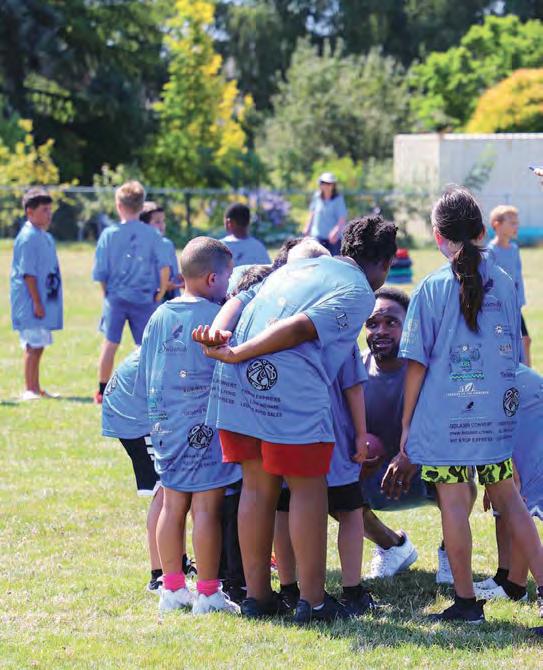

JC (with Rawls) was gifted an autographed ball signed by players in attendance for his outstanding effort at camp. He was one of nine, hand selected by the football legends
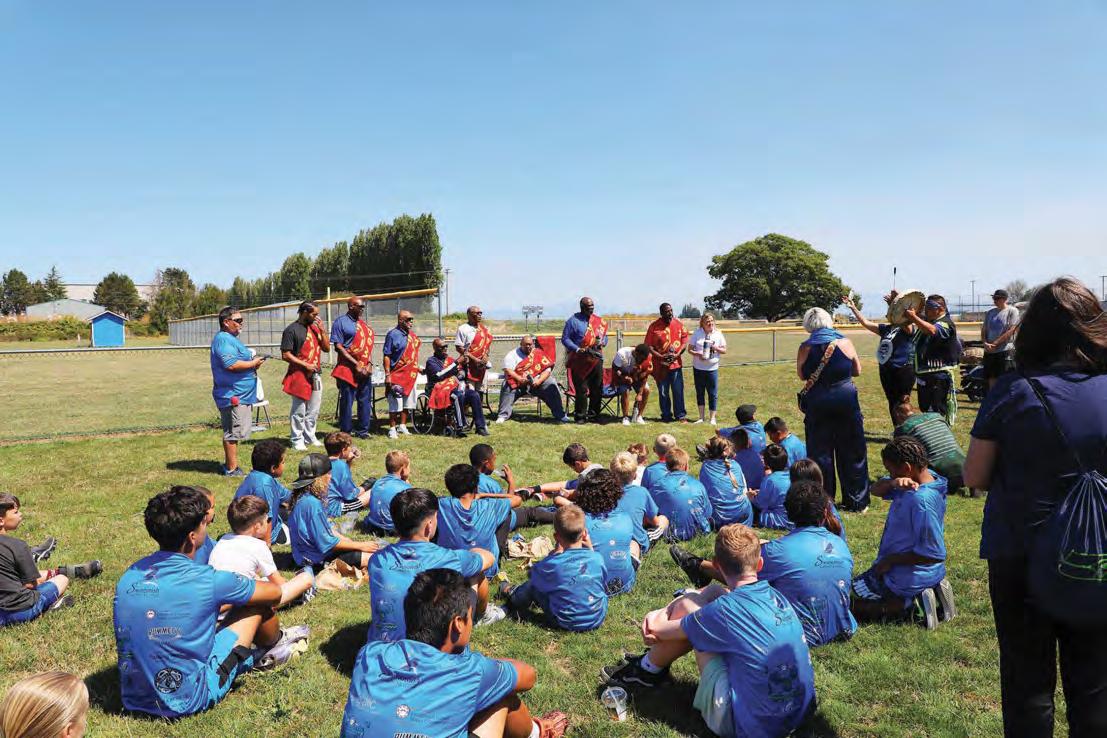
WEDNESDAY, AUGUST 6
Rain and a crab opening didn’t dampen spirits at this year’s March Against Addiction, which continues to be a source of healing for families and the community. The Canoe Family and attendees made their way around the Village, ending at the ball park for some family fun –just in time for the sun to come out.
“We’re a loving, caring, and sharing family here. Those are my grandfather’s words. We take care of one another.” -March Against Addiction Founder Huge Edwards
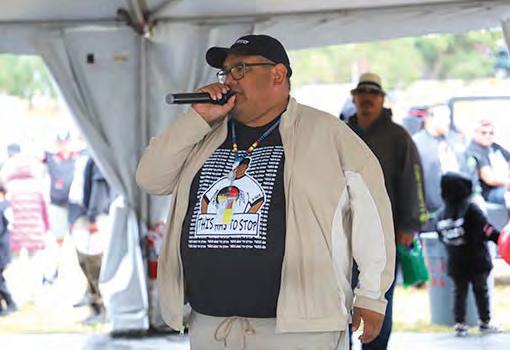

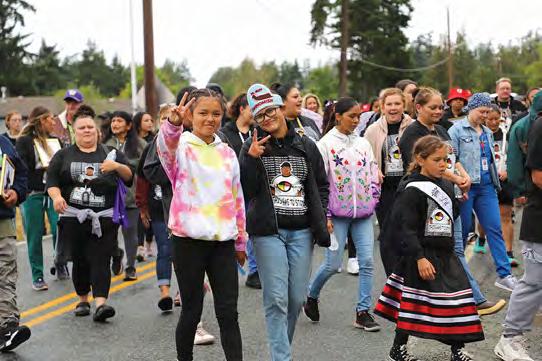


June 8 – In 2021, the Swinomish Tribal Senate declared the last Friday in June as Swinomish Pride Day, passing a resolution to honor and recognize the TwoSpirit and LGBTQ+ community. This year marks the fifth anniversary of that declaration and the ongoing celebration of Swinomish Pride Day. The annual event not only joins the broader observance of Pride Month but also uplifts the Swinomish community through the powerful reminder of unity and to “Be who you are, love who you are.”
Swinomish Pride Day 2025 was celebrated at the swәdәbš Park Amphitheater with music, art, and a seafood feast.
“Pride Day was amazing this year. We celebrated five years with community, food, and powerful queer Indigenous representation. Musicians Mato Wayuhi and Ailani brought incredible energy, and the seafood feast made it feel like a full, joyful gathering,” said Swinomish Pride Day Coordinator Katherine Paul.
“But this celebration is about more than just one day –it’s about support, healing, and creating a space where our families and young people can thrive. Events like this help shift the course of generational trauma and bring more of us together. Five years has already changed so much in our community, and it’s amazing to see that strength keep growing.”















Consider these opportunities to make the best out of your school day!
CHRISTINE VALDEZ, PREVENTION SPECIALIST, LA CONNER SCHOOL
The La Conner School District prevention program provides student opportunities to participate in fun, healthy, positive activities during the school day. Most of the activities are at the middle school, but be on the lookout for new activities at the elementary school. Students can learn about weekly activities by checking the whiteboard in the hallway by Room 210.
ABC Club: Middle school students are encouraged to participate in the ABC Club, which stands for Acceptance, Belonging, and Communication – and Creativity and Collaboration – Club. This group “comes together to make the school better.” The club meets weekly during lunch in Room 210. All are welcome to join, or stop by to check it out!
Sources of Strength: Nominations are being accepted for middle and high school students who want to be trained as Sources of Strength peer leaders. Peer leaders work on campaigns that promote strengths, belonging, positive friendships and gratitude, as well as recognize trusted adults.
Lunchtime Activities: Middle schoolers looking for an alternative to eating in the cafeteria are invited to participate in activities in Room 210 during their lunchtime. Options include art, book clubs, journaling, games, and karaoke. Students are encouraged to offer ideas and collaborate on activities.
Varsity in Volunteerism (ViV): High school students can earn a varsity letter for volunteering by joining ViV and meeting club requirements. Registration is open, and up to 40 hours of summer volunteering can count toward the 100 hours required by May 2026. La Conner ViV is one of several clubs in the county. To learn more or to register, visit unitedgeneral.org/viv/
For more information about these and other offerings, please reach out to Prevention Specialist Christine Valdez, cvaldez@lc.k12.wa.us , (360) 708-2479, or visit the links below.
Visit these links to learn more: Varsity in Volunteerism: unitedgeneral.org/viv Sources of Strength: sourcesofstrength.org About ABC Club: animoto.com/play/M7gYt76xwQgBw06ceAoULQ\ ABC Club Sources of Strength video: animoto.com/play/wX6ckdOTYAYSKREjprIlPg
The Boys & Girls Club sure knows how to karaoke! They had their first session with DJ Tom and it was a hit!



THURSDAY, JULY 17




9.13.2025
Saturday, September 13, 2025
Swinomish Boys and Girls Club (Gymnasium)

Lunch: 1:00 pm
Ceremony: 3:00 pm
qyuuqs@swinomish.nsn.us
@qyuuqsNews
